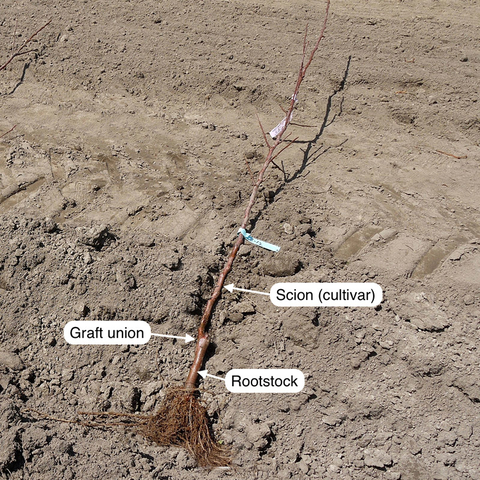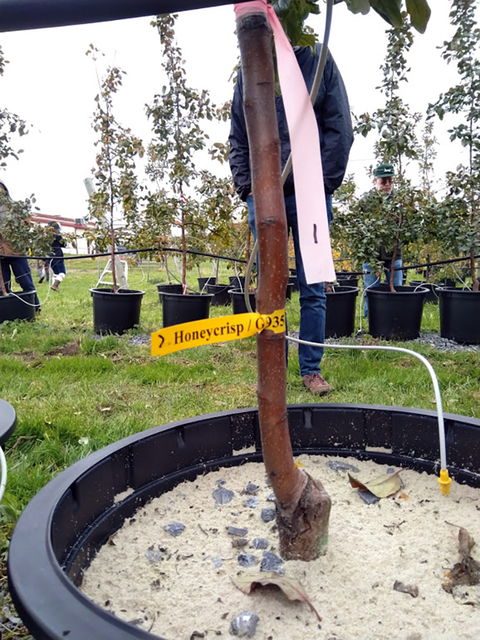Will apple tree stumps grow back?
UNIVERSITY OF MINNESOTA EXTENSION - www.extension.umn.edu
A new grafted apple tree seedling, with the rootstock and scion fused together
One frequently asked fruit tree question is: If I cut down an apple tree, will a new tree grow from the stump?
The short answer is: Yes, but it probably will not produce the fruit that you want or expect.
Most apple trees are “grafted.” This means that the trunk, leaves, branches and fruit of the tree have different genetics than the root system.
Grafted tree saplings are propagated by physically attaching a young apple tree root system (rootstock) to a small branch from a different tree that has the fruit of a desirable variety (called the “scion”). The newly grafted sapling is then placed in a growth media such as potting soil, and the wood from the branch and the root system fuse together, forming one tree. As the tree grows, it produces fruit and leaves that have a different genetic makeup than the roots.
For example, a local orchard may choose to grow Honeycrisp apple trees on three different rootstocks with names like B9, M17, or G935. All will produce the same Honeycrisp fruit, but their roots will have different genetics.
A young Honeycrisp apple tree grafted on a G935 rootstock. The graft union is the bump on the bottom of the trunk.
So how does this relate to a tree stump?
As the tree grows, the graft union remains just a few inches above the ground. When an apple tree is cut down, the cut usually occurs under the graft union. New branches often emerge from apple tree stumps, but their genetics are from the rootstock. As a result, a stump of a grafted tree will not produce the same fruit that the tree once produced. Rootstocks generally do not produce desirable fruit, so growing a tree from branches below the graft union will most likely disappoint you.
If someone cuts an apple tree down above the graft union, then the new branches that emerge may grow from either above or below the graft union.
If the apple tree is own-rooted (not grafted) then the new branches will produce the same fruit as the original tree, but it may take many years for fruit to form.
Why apple trees are usually grafted
Dwarf grafted apple trees are smaller and more efficient to manage than own-rooted apple trees.
There are several reasons why most apple trees are grafted onto rootstocks.
The main reason is to control the size of the tree. Many rootstocks are called “dwarfing” because their genetics cause them to grow slowly and keep the tree small. The resulting dwarf trees are much shorter and narrower than non-grafted trees, and can be planted close together in long rows.
Dense plantings of dwarf trees are easier to harvest and prune. They also produce more apples on less land. This is important as the world population grows and requires more food with fewer resources. Today, most modern apple orchards plant dwarf apple trees rather than larger, non-grafted standard-sized trees.
In addition to size control, some rootstocks provide other desirable traits like disease resistance or cold hardiness.
Even though most apple trees available today are grafted, it is still common to find large own-rooted apple trees on older properties. These were typically planted long ago, and are up to 30 feet tall.
To see if an apple tree is grafted or not, look for a distinct bump on the trunk a few inches above the ground.
Want to graft your own apple trees?
To graft an apple tree, you need a rootstock, scion (small branch) wood, and a very sharp knife. Rootstocks typically have to be purchased. Scion wood can be purchased or collected from a neighbor or friend who grows the variety you desire.
You can find a lot of information online about grafting apple trees. For example, check out this resource from the University of New Hampshire Extension.
For information on the various rootstocks available and how to order them, see this article from the Extension fruit and vegetable growers blog.



